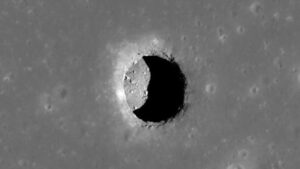Few parts of our galaxy have captured the human imagination quite like the elegant, colorful rings of Saturn.
But like all things in nature, they’re going to disappear, new research says. And soon. Well, soon as in 100 million years, at the earliest.
Assuming the human species survives another 1,000 years, that means the rings will still be around long enough for any potential space tourism.
In the context of the universal timeline, however, Saturn’s rings have a much shorter lifespan than once believed. They likely formed within the last few hundred million years, when dinosaurs roamed the Earth.

This was Cassini’s view from orbit around Saturn on Jan. 2, 2010. Photo composite: NASA
That’s according to the new analysis of data from NASA’s Cassini mission, which orbited the gas giant between 2004 and 2017. The research, published May 15 in the journal Icarus, posits that the rings appeared long after the formation of Saturn itself.
More importantly, the Cassini data suggests the rings are losing tons of mass every second.
With other studies reaching the same conclusion this month — one in Science Advances and a second in Icarus — it’s likely that astronomers can rely on this new perspective on Saturn’s iconic rings.
“Our inescapable conclusion is that Saturn’s rings must be relatively young by astronomical standards, just a few hundred million years old,” Indiana University Professor Emeritus of Astronomy Richard Durisen said in a news release. “If you look at Saturn’s satellite system, there are other hints that something dramatic happened there in the last few hundred million years.”

Saturn’s rings display their subtle colors in this view captured on Aug. 22, 2009, by NASA’s Cassini spacecraft. Photo: NASA
Debate about Saturn’s rings
The possible origins of Saturn’s icy rings have long fascinated scientists — even more than its many moons.
For the new study, Durisen worked with Paul Estrada, a research scientist at NASA’s Ames Research Center. The pair have argued for years that Saturn’s rings are young by cosmic standards, as older rings would likely be darker from the effect of interplanetary meteoroids, according to the Indiana University release.
That theory holds up in their latest analysis of data collected by NASA’s Cassini spacecraft over 13 years. In its 2017 Grand Finale, the spacecraft made 22 orbits, frequently passing between Saturn and its rings. The data enabled Durisen and Estrada to estimate the rings’ age and longevity.
The results? Meteoroids will definitely pollute Saturn’s rings. They just haven’t had lots of time to do so because the rings are relatively young. As the rings suffer repeated impacts from these flying space rocks, their dusty essence slowly erodes, with tons of ring mass drifting down to Saturn every second.

Two kinds of dramatic shadows play across the face of Saturn in this view from NASA’s Cassini spacecraft from Dec. 6, 2007. Photo: NASA
It’s a glimpse into a cosmic cycle that has likely taken place many times throughout the Milky Way galaxy — in a distant past before Earth-orbiting telescopes and NASA spaceships.
“We have shown that massive rings like Saturn’s do not last long,” Estrada said. “One can speculate that the relatively puny rings around the other ice and gas giants in our solar system are leftover remnants of rings that were once massive like Saturn’s. Maybe sometime in the not-so-distant future, astronomically speaking, after Saturn’s rings are ground down, they will look more like the sparse rings of Uranus.”
Want to know more? Check out this Indiana University video of Durisen explaining his research.






